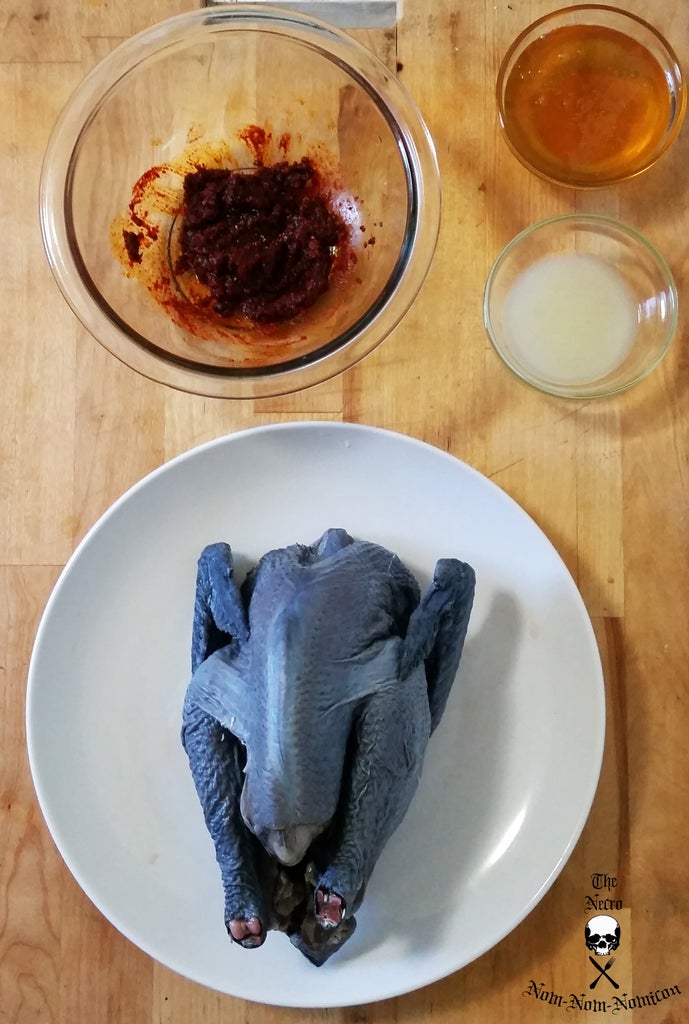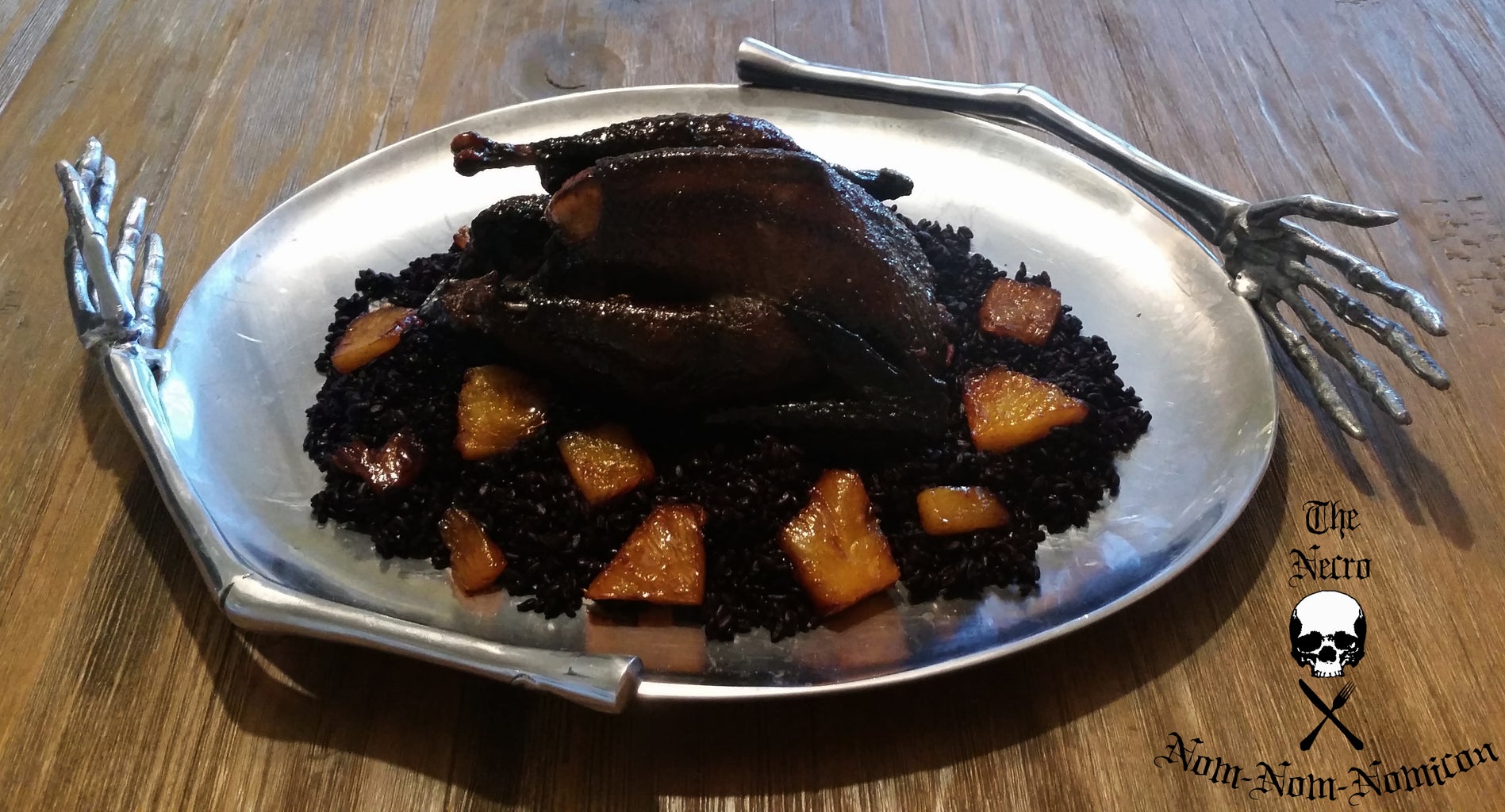Have you ever walked past an Asian grocery store and spotted something that looks like it escaped from a goth farmer’s market? That’s probably black chicken, and yes, it’s actually black – we’re talking skin, meat, bones and all!
When I first encountered a Silkie chicken (the most common black chicken breed), I thought someone had played a prank. But this unusual bird isn’t dyed or manipulated – its striking color comes from a genetic condition called fibromelanosis, causing natural hyperpigmentation throughout the bird.
After experimenting with several cooking methods, I’ve put together this comprehensive guide to help you transform this exotic ingredient into a delicious meal that will impress your dinner guests.
What Exactly Is Black Chicken?
Before diving into cooking techniques let’s understand what makes black chicken special
- Origin: Black chicken originates from Asia, particularly China
- Common breed: Silkie chicken is the most well-known black chicken variety
- Appearance: Features black skin, bones, meat, and even internal organs
- Taste profile: Leaner than regular chicken with a slightly gamey, duck-like flavor
- Texture: Firmer meat that benefits from specific cooking techniques
- Cost: Usually pricier than regular chicken ($15-30 for a whole bird)
As one source perfectly described it, Silkies look like “they’re on the lam from a Goth KFC.” This description made me laugh but it’s weirdly accurate!
Where to Find Black Chicken
You won’t typically find black chicken at your regular supermarket. Here’s where to look:
- Asian grocery stores and markets
- Specialty butcher shops
- Farmers’ markets with exotic poultry vendors
- Online specialty meat retailers
Preparing Your Black Chicken
Selection Tips
When choosing your black chicken:
- Look for birds around 4-5 pounds
- Check for smooth, intact black skin without blemishes
- Fresh is ideal, but properly thawed frozen birds work too
Initial Preparation
- Remove any remaining feathers (Silkies have fluffy, fur-like feathers)
- Remove innards if not already done
- Rinse thoroughly under cold water
- Pat dry with paper towels (especially important if you plan to roast)
Enhancing Moisture and Flavor
Since black chicken is leaner than regular chicken, it benefits greatly from pre-treatment:
Brining Option:
- Create a solution of water, salt, sugar, and optional aromatics
- Submerge chicken for 6-12 hours in refrigerator
- This helps retain moisture during cooking
Marinating Option:
- Combine soy sauce, ginger, garlic, rice wine, and touch of sugar
- Marinate at least 4 hours, preferably overnight
- Helps tenderize and flavor the meat
Best Cooking Methods for Black Chicken
Due to its leaner, tougher nature, black chicken shines with low, slow cooking methods that preserve moisture.
1. Braising (Highly Recommended)
Braising is arguably the best technique for black chicken:
- Sear chicken in hot oil until browned on all sides
- Remove chicken and sauté aromatics (ginger, garlic, scallions)
- Add broth, soy sauce, and seasonings
- Return chicken to pan, ensuring it’s mostly submerged
- Simmer covered on low heat for 2-3 hours until fork-tender
2. Slow Cooking
Perfect for busy days:
- Optionally sear chicken for enhanced flavor
- Place in slow cooker with broth, vegetables, and seasonings
- Cook on low for 6-8 hours or high for 3-4 hours
- Check for tenderness – meat should easily pull away from bone
3. Soup and Stew Preparation
Black chicken makes exceptionally flavorful soups:
- Place whole chicken in large pot
- Cover with water or broth
- Add aromatics (ginger, garlic, scallions)
- Simmer 2-3 hours until very tender
- Remove chicken, shred meat
- Strain broth and return to pot
- Add vegetables, noodles, or other ingredients
- Return shredded chicken to soup
4. Roasting (With Special Considerations)
Roasting requires extra care to prevent drying:
- Thoroughly dry chicken
- Rub with oil/butter and seasonings
- Roast at lower temperature (325°F/160°C)
- Baste frequently
- Cook until internal temperature reaches 165°F/74°C
- Allow to rest before carving
A Killer Roasted Black Silkie Recipe with Smoked Paprika Rub
Here’s a standout recipe adapted from my sources that showcases the unique qualities of black chicken:
Ingredients:
- 1 whole 4-5 pound Black Silkie chicken
- 2 Tablespoons smoked paprika
- 2 Tablespoons unsalted butter, melted
- 1 Teaspoon garlic powder
- 1 1/2 Teaspoons salt
- 1/2 Teaspoon black pepper
- 4 Tablespoons honey
- 2 Tablespoons lemon juice
- 1/2 Tablespoon lime juice
- 1/4 Teaspoon Cayenne pepper
Directions:
- Preheat oven to 325°F/162°C
- Clean chicken, remove head and lower legs if needed
- Pat chicken very dry with paper towels
- Mix paprika, melted butter, garlic powder, salt, pepper, and cayenne into a paste
- Reserve 1 teaspoon of paste for later
- Rub remaining paste thoroughly onto chicken skin
- Place chicken in shallow roasting pan and roast for 35 minutes
- Meanwhile, combine honey, lemon juice, lime juice, and reserved rub into a baste
- After 35 minutes, remove chicken and baste with glaze
- Return to oven for additional 45 minutes, basting every 15 minutes
- Check for doneness with meat thermometer (160°F/70°C breast, 165°F/73°C thigh)
- Rest before serving
This recipe produces a chicken with a beautiful contrast between the black skin and the reddish-brown paprika rub, plus the sweet-tangy glaze balances the rich flavor of the meat.
Flavor Combinations That Complement Black Chicken
Black chicken pairs beautifully with various flavor profiles:
Chinese-inspired:
- Ginger, garlic, scallions
- Soy sauce, rice wine
- Star anise, cinnamon
Korean-inspired:
- Gochujang (Korean chili paste)
- Sesame oil, garlic, ginger
- Gochugaru (Korean chili flakes)
Moroccan-inspired:
- Cumin, saffron
- Preserved lemon
- Fresh herbs like parsley and cilantro
Indian-inspired:
- Garam masala, curry powder
- Cilantro, yogurt
- Turmeric, cumin, coriander
Side Dishes That Pair Well with Black Chicken
The unique flavor of black chicken complements these sides:
- Black “forbidden” rice – creates a visually striking plate and has nutty flavor
- Stir-fried vegetables with soy sauce or oyster sauce
- Mushroom dishes that enhance the earthy qualities
- Pickled vegetables for brightness and acidity
- Root vegetables like carrots, turnips, and potatoes
Frequently Asked Questions About Cooking Black Chicken
Q: What does black chicken taste like?
A: It tastes richer and gamier than regular chicken, with notes reminiscent of duck. The flavor is often described as more earthy and intense.
Q: Is black chicken healthier than regular chicken?
A: Black chicken is leaner and contains less fat. Some studies suggest it has higher levels of carnosine, which has antioxidant properties. The black meat may be better for you than white meat according to some research.
Q: How do I know when black chicken is cooked through?
A: Because of the dark meat, visual cues aren’t reliable. Use a meat thermometer to ensure the internal temperature reaches 165°F (74°C) in the thickest part of the thigh.
Q: Can I use regular chicken recipes for black chicken?
A: Yes, but you’ll need to adjust cooking times and methods. Focus on slower cooking and moisture retention techniques.
Q: Can I freeze cooked black chicken?
A: Yes, allow it to cool completely then wrap tightly in freezer-safe packaging or place in airtight containers.
The Bottom Line on Cooking Black Chicken
Cooking black chicken requires some adjustments from your standard poultry preparation, but the effort yields a unique culinary experience worth exploring. The key takeaways:
- Cook low and slow to tenderize the meat
- Maintain moisture through brining, marinating, or moist cooking methods
- Embrace bold flavors that complement the chicken’s unique profile
- Use a thermometer rather than visual cues to determine doneness
I’ve cooked black chicken several times now, and I’m still amazed by how dramatic it looks on the plate. My dinner guests are always intrigued by the black bones and skin – it’s definitely a conversation starter!
Whether you’re looking to explore new culinary territory or impress guests with something exotic, black chicken offers a delicious adventure beyond the ordinary. Give these techniques a try, and you might find yourself seeking out this unique ingredient regularly!
Have you tried cooking black chicken before? I’d love to hear about your experiences in the comments below!

Step 3: Mixing Up Your Rub

Rinse off your Silkie and pat dry with a paper towel.
You will want the skin dry so the rub will adhere well. Too wet and it will slide off.
Mix together the paprika, melted butter, garlic powder, salt, pepper and cayenne until it forms a thick paste.
Reserve 1 Teaspoon of your paste and set aside for later.
Introduction: Fowl Most Foul – Roasted Black Silkie Chicken With Smoked Paprika Rub

There are few birds quite so beautifully suited to a dark dinner as the Black Silkie, a small chicken with naturally occurring black bones and skin and dark rich meat. Before you think the color of this chicken is a result of photo manipulation or dye, let me assure you, this is how these chickens are born and bred. The black color is a result of fibromelanosis, a rare genetic mutation of hyperpigmentation and is 100% natural.
Not only do Silkies look like the’re on the lam from a Goth KFC, they are leaner than the typical roasting bird, resulting in a meat that is far less greasy than the usual fowl you pick up at the store. What they lack in grease, however, is more than made up for with taste. A Silkie tastes a bit like a traditional roasted chicken, but with a light touch of duck, giving it a subtle, exotic flavor that lends itself well to the smoky flavor of the paprika rub in this recipe.
